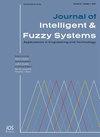Implementation of a quantum machine learning model for the categorization and analysis of COVID-19 cases
IF 1
4区 计算机科学
Q3 COMPUTER SCIENCE, ARTIFICIAL INTELLIGENCE
引用次数: 0
Abstract
Coronavirus is a new pathogen that causes both the upper and lower respiratory systems. The global COVID-19 pandemic’s size, rate of transmission, and the number of deaths is all steadily rising. COVID-19 instances could be detected and analyzed using Computed Tomography scanning. For the identification of lung infection, chest CT imaging has the advantages of speedy detection, relatively inexpensive, and high sensitivity. Due to the obvious minimal information available and the complicated image features, COVID-19 identification is a difficult process. To address this problem, modified-Deformed Entropy (QDE) algorithm for CT image scanning is suggested. To enhance the number of training samples for effective testing and training, the suggested method utilizes QDE to generate CT images. The retrieved features are used to classify the results. Rapid innovations in quantum mechanics had prompted researchers to use Quantum Machine Learning (QML) to test strategies for improvement. Furthermore, the categorization of corona diagnosed, and non-diagnosed pictures is accomplished through Quanvolutional Neural Network (QNN). To determine the suggested techniques, the results are related with other methods. For processing the COVID-19 imagery, the study relates QNN with other existing methods. On comparing with other models, the suggested technique produced improved outcomes. Also, with created COVID-19 CT images, the suggested technique outperforms previous state-of-the-art image synthesis techniques, indicating possibilities for different machine learning techniques such as cognitive segmentation and classification. As a result of the improved model training/testing, the image classification results are more accurate.实现用于COVID-19病例分类和分析的量子机器学习模型
冠状病毒是一种可以引起上呼吸道和下呼吸道疾病的新型病原体。全球COVID-19大流行的规模、传播速度和死亡人数都在稳步上升。可以使用计算机断层扫描检测和分析COVID-19实例。对于肺部感染的鉴别,胸部CT成像具有检测速度快、价格相对低廉、灵敏度高的优点。由于可用信息明显很少,图像特征复杂,因此COVID-19识别是一个困难的过程。针对这一问题,提出了一种基于改进变形熵(QDE)的CT图像扫描算法。为了增加有效测试和训练的训练样本数量,该方法利用QDE生成CT图像。检索到的特征用于对结果进行分类。量子力学的快速创新促使研究人员使用量子机器学习(QML)来测试改进策略。此外,利用量子神经网络(QNN)对诊断和未诊断的冠状病毒图像进行分类。为了确定建议的技术,结果与其他方法相关联。对于COVID-19图像的处理,本研究将QNN与其他现有方法联系起来。与其他模型相比,建议的技术产生了更好的结果。此外,对于创建的COVID-19 CT图像,建议的技术优于以前最先进的图像合成技术,这表明了认知分割和分类等不同机器学习技术的可能性。经过改进的模型训练/测试,图像分类结果更加准确。
本文章由计算机程序翻译,如有差异,请以英文原文为准。
求助全文
约1分钟内获得全文
求助全文
来源期刊

Journal of Intelligent & Fuzzy Systems
工程技术-计算机:人工智能
CiteScore
3.40
自引率
10.00%
发文量
965
审稿时长
5.1 months
期刊介绍:
The purpose of the Journal of Intelligent & Fuzzy Systems: Applications in Engineering and Technology is to foster advancements of knowledge and help disseminate results concerning recent applications and case studies in the areas of fuzzy logic, intelligent systems, and web-based applications among working professionals and professionals in education and research, covering a broad cross-section of technical disciplines.
 求助内容:
求助内容: 应助结果提醒方式:
应助结果提醒方式:


